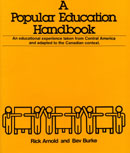
A Popular Education Handbook
An educational experience taken from Central America and adapted to the Canadian context
Arnold, Rick and Burke, Bev
Publisher: CUSO Development Education, Ottawa, Canada
Year Published: 1983
Pages: 59pp Price: $3.95 Resource Type: Pamphlet
Cx Number: CX2942
Abstract:
Subtitled "An Educational Experience Taken From Central America And Adapted To The Canadian Context," this handbook takes its inspiration from three years the authors spent living and working in Central America. There, they were influenced by the "popular education" approach to adult education that they experienced, especially in Nicaragua. The booklet is the product of over 40 workshops in which they attempted to adapt what they learned in Central America to education about social issues in Canada. Beginning with an overview of popular education methodology, the booklet goes on to outline several specific workshop examples. This is followed by a detailed "how to" of five creative methods used within the workshops: "human sculpturing", "socio-drama," "role play," drawing, and song-writing. A section on "Build Your Own Resources" looks specifically at how to put together a slide-tape production.
The authors define popular education as having the following characteristics: 1. The starting point is the concrete experience of the learner. 2. Everyone teaches; everyone learns. 3. Involves a high level of participation. 4. Leads to action for change. 5. Is a collective effort; focusing on group rather than individual solutions to problems. 6. Stresses the creation of new knowledge, rather than the passing on of existing knowledge. 7. The process is ongoing - any time, place, or age. 8. It's fun.
Table of Contents
Introduction
Chapter One: Popular Education
What is it; where does it come from; characteristics of popular education; what do we need to know to plan a popular education program; the overall plan or methodology; what's the role of the popular educator.
Chapter Two: Program Examples
Introduction
Example 1: A workshop for teachers about popula education in Central America
Example 2: A workshop on working people in Canada and Central America
Example 3: A workshop on popular education for community growth
Chapter Three: Tools for Building a Popular Education Program
3.1 Introduction
3.2 Sculpturing
3.3 Sociodrama
3.4 Role Play
3.5 Drawing
3.6 Songwriting
Chapter Four: Exercises to Help the Group Process
Introductions/Breaking the Ice; Secret Admirer/Group Building; Tide's in - Tide's out/Relaxation and Fun.
A Review Checklist
Chapter Five: Building Our Own Resources: Why bother?
Introduction; How to put together a slide-tape show; A list of slide-tape shows we've put together on Central America
Bibliography
Subject Headings


